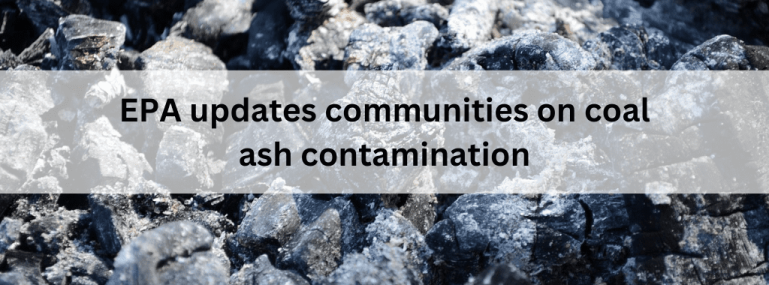On April 17, 2015, EPA announced the latest action on protecting communities from coal ash contamination and ensuring the polluters are accountable for controlling and cleaning the contamination created by them by the disposal of coal ash (CCR), which can leak into groundwater and cause high health risks to communities living nearby. By adopting this rule, coal ash will be disposed of and managed in areas that are not currently regulated by federal law. Moreover, this rule will require coal-fired power plant owners to disclose information about how CCR is managed and disposed of. Additionally, the EPA will require inspections and corrective action if needed.
The burning of coal in power plants will result in the creation of coal as a by-product. This coal ash can be a serious threat to waterways, air, and drinking water, as well as the most valuable source of water to humans, groundwater, if not properly handled. Coal ash is contaminated with a variety of chemicals such as chromium, mercury, arsenic, and cadmium. It is also associated with various other health risks that pose a high risk of cancer as well as other adverse effects on the body. In addition to protecting underserved communities, this proposal shows the administration’s commitment to environmental justice at the state level, which reflects its commitment to environmental justice at the national level.
It has been found that facilities that are currently operating with legacy CCR-contaminated coal ash surface impoundments are less likely to have structural problems than facilities that are inactive with legacy CCR-contaminated coal ash surface impoundments. In 2018, a federal court directed the EPA to investigate this gap in regulation at the federal level, as these inactive units are currently unregulated at the federal level.
Amidst all this, after the CCR 2015 rule was implemented, the Environmental Protection Agency found that the plants that are currently operating are also discharging coal ash units outside of the regulated area, in addition to the CCR 2015 rule.
To finalize the proposal, EPA will consult with the power sector and other interested parties. This is to ensure that this proposal reflects the Administration’s commitment to reducing pollution from the power sector while providing long-term regulatory certainty and operational flexibility.
In response to these proposals, the EPA is accepting public comments on Regulations.gov starting 17 May 2023 for a 60-day period. Furthermore, the EPA will engage in a public outreach campaign in addition to the in-person and virtual hearings.
ComplianceXL will help them assess the EPA’s actions and develop a plan to ensure the proposal meets compliance requirements. ComplianceXL can also provide guidance on how to ensure compliance with the EPA’s latest regulations. Additionally, ComplianceXL can provide insights into how to reduce pollution in the power sector. This will help the company stay ahead of the curve and reduce the risk of non-compliance with EPA’s regulations. Talk to one of our global compliance specialists today!
FAQs
1. How does coal ash affect the environment?
The by-product of burning coal for electricity is coal ash. The mixture contains various pollutants and toxic substances, such as heavy metals (e.g., arsenic, lead, mercury), which pose health and environmental risks.
2. How has the EPA addressed coal ash contamination?
EPA regulations established minimum requirements for coal ash disposal and management in 2015, known as the Coal Combustion Residuals (CCR) rule. In order to protect human health and the environment, these regulations aim to prevent and minimize contamination releases into the environment.





